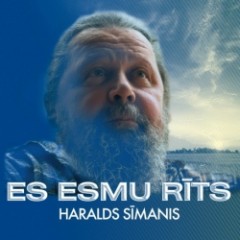
One of the most unique voices in Latvian music, if not the most unique and distinctive, not to mention one of the most unique personalities, is singer/guitarist/songwriter Haralds Sīmanis.
With his long hair and beard, and voice that went from a growling bass to a melodic falsetto, he first made his mark in 1980 with the song ‘Ezers’, a song that was quite dramatically different from the Latvian popular music of the day. In fact, it might be even considered the first (if, perhaps, only) example of Latvian progressive rock.
Though ‘Ezers’ was a hit and a particularly memorable song, Sīmanis has remained a bit of a mystery over the past thirty years – slightly eccentric, not particularly prolific, he pops up every now and then only to disappear. It seems likely that he simply avoids the limelight, and prefers to stay low key.
Sīmanis again reentered the public eye in 2012 in two ways. First, the song ‘Ezers’ was performed by Agita Gabranova on the talent show ‘Latvijas zelta talants 2012’ in one of the most memorable performances of that event, which introduced the song and Sīmanis to a younger generation. Second, Sīmanis re-recorded a number of his songs in a stripped-down acoustic style and released the album Es esmu rīts.
Es esmu rīts features eleven of Sīmanis’ compositions (all the lyrics for all of Sīmanis’ songs are written by Arvīds Ulme), and these new interpretations reveal, once again, the true uniqueness and style of Sīmanis’ performances, and reaffirm his status as one of the most eclectic of Latvian songwriters.
Featuring Sīmanis on guitar and vocals, Andris Grunte on contrabass, and Ilze Grunte on guitars and additional instruments, the album provides a quite satisfying overview of Sīmanis’ eclectic songwriting and singing style.
The song ‘Es esmu rīts’ features Ilze Grunte playing the baglama, a guitar-like instrument used in Greek and Turkish music, and gives the song a rich Middle Eastern feel to it, particularly the contrabass solo by Andris Grunte. The same Middle Eastern feel is used to great effect on the song ‘Bezgaismā’.
Andris also features on ‘Zied zāle’, playing a memorable introduction on the contrabass, and Sīmanis, his voice nearly a scream, builds to a powerful crescendo at the end of the song.
Of course, ‘Ezers’, his best known composition, also appears on the album, and though the melody remains the same, in this new arrangement the song is given a fresh update – the stripped-down approach brings forth Sīmanis’ voice. What is also interesting is that this recording restores the third verse, which did not appear in the 1980 original as it did not pass the Soviet censors.
Sīmanis reaffirms his position as one of the most unique of Latvian performers with the release of Es esmu rīts. Though not prolific, every new Sīmanis release is a treat, and Es esmu rīts is no different.
Interested listeners may also want to seek out Starp divām gaismām, a 2006 re-release by MicRec of Sīmanis’ 1997 album Starp divām gaismām (as well as a number of other songs from the 1980s and 90s, including the original version of ‘Ezers’). For those seeking something particularly unique in Latvian music, Es esmu rīts exhibits one of Latvia’s finest songwriters and one of its most distinctive voices.
Details
Es esmu rīts
Haralds Sīmanis
Latvia: Biedrība Kultūras Menedžmenta centrs Lauska, 2012
Track listing:
1. Māls
2. Es esmu rīts
3. Tavs pirmais sniegs
4. Divi sārti zvaniņi
5. Bezgaismā
6. Zied zāle
7. Ne nieka
8. Es aizeju
9. No rīta
10. Kurstmāte Baltā
11. Ezers
© 1995-2024 Latvians Online
Please contact us for editorial queries, or for permission to republish material. Disclaimer: The content of Web sites to which Latvians Online provides links does not necessarily reflect the opinion of Latvians Online, its staff or its sponsors.





Look, “unique” is like “pregnant” — there are no degrees of unicity. Either a thing is unique or it is not, and that’s all there is to it. So “most unique” is a meaningless expression. “Most distinctive” is fine, but please, not “most unique.” Visvienreizākais? Visvienīgākais? Just say no.